Oil-tanned leather offers superior softness and water resistance due to its infusion with natural oils, making it ideal for durability and flexibility in rugged conditions. Waxed leather, coated with a wax finish, provides a distinct glossy sheen and enhanced protection against moisture and stains while maintaining a stiffer texture. Both types are prized for their unique aesthetic and functional qualities, with oil-tanned leather favored for comfort and waxed leather for its rugged, polished appearance.
Table of Comparison
| Feature | Oil-Tanned Leather | Waxed Leather |
|---|---|---|
| Processing | Infused with natural oils for softness and durability | Coated with wax for a water-resistant, glossy finish |
| Water Resistance | Moderate, absorbs water but dries evenly | High, repels water effectively due to wax layer |
| Texture & Appearance | Soft, matte finish with natural patina over time | Smooth, shiny surface that darkens with wear |
| Durability | Strong, resistant to cracking and fading | Durable but wax layer may wear off, requiring reapplication |
| Maintenance | Minimal; occasional oiling recommended | Regular re-waxing needed to maintain protection |
| Common Uses | Footwear, work boots, outdoor gear | Bags, jackets, casual footwear |
Introduction to Oil-Tanned and Waxed Leather
Oil-tanned leather is produced by infusing natural oils during the tanning process, resulting in a flexible, water-resistant material with a rich, deep patina. Waxed leather undergoes a finishing treatment where waxes are applied to the surface, enhancing its water repellency and providing a distinctive sheen and texture. Both types are prized for durability and vintage aesthetic, commonly used in footwear, bags, and outdoor gear.
Defining Oil-Tanned Leather
Oil-tanned leather is a type of leather treated with natural oils during the tanning process, enhancing its durability, water resistance, and softness. This treatment results in a supple texture that ages beautifully with rich patina over time. Unlike waxed leather, which has a surface coating, oil-tanned leather's protection is throughout the material, offering long-lasting resilience.
What Is Waxed Leather?
Waxed leather is a type of leather treated with natural or synthetic waxes, enhancing its water resistance and durability while providing a smooth, slightly glossy finish. This treatment creates a protective barrier that helps repel moisture and dirt, making waxed leather ideal for outdoor gear and accessories. Unlike oil-tanned leather, which relies on oils to soften and preserve the hide, waxed leather's coating improves surface protection without significantly altering the leather's flexibility.
Key Differences in Production Processes
Oil-tanned leather undergoes a tanning process involving natural oils and waxes that penetrate deep into the hide, enhancing flexibility and water resistance. Waxed leather is treated with surface-applied waxes or oils after tanning, creating a protective, glossy finish that improves durability and weather resistance. The primary difference lies in oil-tanning integrating oils during tanning, while waxed leather receives external wax applications post-tanning.
Appearance and Texture Comparison
Oil-tanned leather exhibits a rich, deep color with a supple, almost buttery texture that softens over time, developing a unique patina reflecting its natural oils. Waxed leather, by contrast, features a slightly stiffer feel with a semi-glossy finish that enhances water resistance and showcases a textured, rugged appearance. Both types age distinctively, with oil-tanned leather gaining a smooth sheen and waxed leather revealing subtle cracks and creases adding character to the surface.
Durability and Wear Over Time
Oil-tanned leather features deeply infused oils that enhance water resistance and flexibility, resulting in superior durability and a soft patina as it ages. Waxed leather has a surface coating of wax that provides a glossy finish and initial water repellency but tends to wear off faster, revealing the raw leather underneath. Over time, oil-tanned leather maintains structural integrity and develops a rich texture, whereas waxed leather may require more frequent reapplication to preserve its protective qualities.
Water Resistance: Oil-Tanned vs Waxed
Oil-tanned leather offers superior water resistance due to the deep penetration of oils during the tanning process, creating a durable, flexible surface that repels moisture effectively. Waxed leather features a protective wax coating on the surface, providing excellent initial water repellency but requiring periodic reapplication to maintain its barrier. Both types withstand wet conditions well, but oil-tanned leather excels in long-term water resistance without frequent maintenance.
Maintenance and Care Tips
Oil-tanned leather requires regular conditioning with specialized leather oils to maintain its suppleness and water resistance, while avoiding excessive moisture that can cause stiffness. Waxed leather benefits from periodic application of wax-based conditioners to preserve its protective coating and enhance durability against harsh elements. For both types, cleaning should be done gently with a soft cloth and mild leather cleaner, avoiding harsh chemicals to prevent damage.
Common Uses and Applications
Oil-tanned leather is commonly used in rugged outdoor gear, work boots, and saddlery due to its water resistance, durability, and supple texture. Waxed leather finds frequent applications in fashion accessories, such as bags and jackets, where a polished, glossy finish and enhanced abrasion resistance are desired. Both types provide excellent longevity, but oil-tanned leather excels in moisture-heavy environments while waxed leather suits stylish, everyday wear.
Which Leather Type Should You Choose?
Oil-tanned leather excels in durability and water resistance, making it ideal for rugged outdoor use and heavy wear, while waxed leather offers a softer feel and a unique patina that develops over time, perfect for casual or fashion accessories. Choosing between the two depends on your need for toughness versus aesthetic appeal, as oil-tanned leather requires less maintenance, whereas waxed leather benefits from periodic re-waxing to maintain its finish. Both types age beautifully, but oil-tanned leather withstands harsh conditions better, whereas waxed leather prioritizes style and a vintage look.
Oil-Tanned Leather vs Waxed Leather Infographic

 materialdif.com
materialdif.com